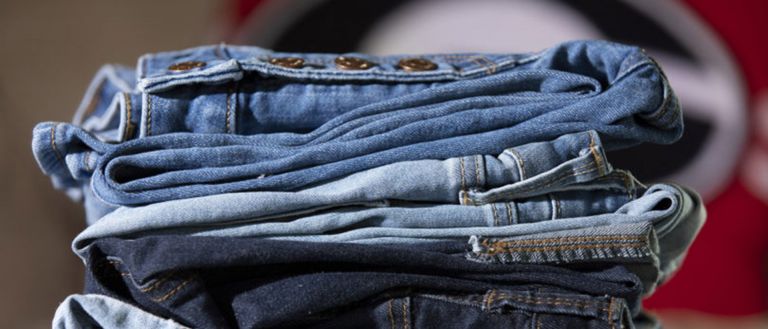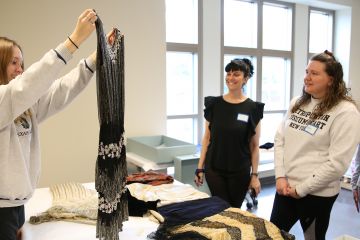Taking textiles from trash to treasure
Thirty years ago, on Earth Day 1990, textile engineer Gajanan Bhat was at his first job, working for a company that used recycled plastic bottles to make carpets. Three decades later, on the 50th anniversary of Earth Day, the University of Georgia professor is tackling another environmental challenge—reducing textile waste headed for landfills by recycling it into useful products.
In 2017, 16.89 million tons of textiles were produced in the U.S. Only 15% of that was recycled and almost two-thirds (11.2 million tons) was discarded to landfills, according to the Environmental Protection Agency. Such waste pollutes the environment by contaminating groundwater and forming greenhouse gases when decomposing.
But a study by a team including Bhat and first author Shafiqul Islam, a Ph.D. student at UGA, confirms that recycled textile waste can be used to produce acoustic insulation materials that rival those currently available on the commercial market.
“If we can use significant amounts of recycled products, instead of using new materials for these products, it will reduce the amount of waste going into landfills,” said Bhat, Georgia Athletic Association Professor of Fibers and Textiles in the College of Family and Consumer Sciences. “It will also open up other opportunities for textile waste when people see this and think, ‘We can use that here, too.’”
In the 30 years since Bhat began his career, there’s been tremendous growth in textile production and consumption based on factors like fast fashion, or inexpensive clothing produced rapidly by mass-market retailers in response to the latest trends.
“It’s an old joke among professors—we have the same suit from 20 years ago, but our kids’ closets change much quicker,” he said. “That’s the reality.”
The ability to produce fabrics at lower production costs has contributed to a throwaway mentality when it comes to how long clothes are worn. Bhat likens it to the way we treat disposable packaging.

“If you buy coffee, they give it to you in a Styrofoam cup or something that’s not valuable, and you discard it,” he said. “If it was an expensive cup, we wouldn’t throw it away. We would return it, recycle it or reuse it.”
In addition to reducing the amount of textiles going into landfills, using recycled textile waste to produce acoustic insulation materials will help address noise pollution, a growing problem due to urbanization, industrialization and increased use of vehicles, electrical and mechanical appliances in homes and offices. Negative health effects of noise pollution can include stress, high blood pressure, coronary heart disease and stroke.
It’s a win-win solution, but there are challenges, according to Bhat.
“Lots of work is necessary to produce acoustic materials from recycled textiles that are compatible with what’s commercially available,” he said. “The goal is to produce insulation materials that are lightweight, thin, cost-effective and have very good acoustic and thermal insulation properties.”
For one of the studies, Bhat and his team created composite samples made of recycled denim fibers—mainly cotton—combined with compostable fibers using nonwoven techniques. Nonwoven fabrics are bonded together by chemical, mechanical, heat or solvent treatment. They are considered ideal for insulation materials due to their unique fiber orientation and porous structure.
Bhat’s composite samples mixed recycled denim with PLA or Sorona at different ratios. PLA (polylactic acid) is a biodegradable and bio-based polyester derived from renewable resources such as corn sugar, potato and cane sugar. Sorona, created by DuPont, is a commercial fiber derived from sugar.
After the denim and compostable fibers were blended and a loose mat of fibers was produced, heat and pressure were applied to create four composite panels with varying fiber compositions, temperature, pressure and number of layers. Three of those samples used Sorona fiber as binder, and the fourth used PLA.
The samples were characterized for a number of variables including porosity, thickness and density, fiber diameter and acoustic properties. An impedance tube with four microphones was used to measure their acoustic properties. Each individual sample was placed in the tube with two microphones on each side, and a single frequency sound was generated and passed through the sample.
All four samples from recycled denim blocked sound transmission by several decibels more than gypsum board of comparable thickness, one of the most commonly used building insulation materials.
“We’ve shown that recycled textiles have great potential to be used as acoustic insulating materials,” Bhat said. “They perform as well or better than commercially available materials and could be used in buildings, cars and even appliances.”
This paper is under review at the Journal of Industrial Textiles. Co-authors include Partha Pratim Sikdar, UGA; Magdy El Messiry, Alexandria University, Egypt; and Joshua Seylar, University of Akron.
It’s an old joke among professors—we have the same suit from 20 years ago, but our kids’ closets change much quicker.




